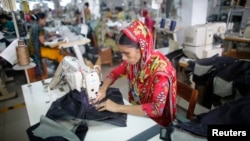Two years after the deadly collapse of Rana Plaza in Bangladesh, thousands of garment factories are trying to meet international safety standards. Giving workers a voice and protecting their rights is considered a critical part of ensuring safe labor conditions. The effort includes educating and organizing the workers who are at the core of Bangladesh's economic engine.
Friday is a day of prayer and rest in Bangladesh and many of the country’s four million garment workers have the day off.
But this means that Friday is the busiest day for the Bangladesh Independent Garment Workers Union Federation (BIGUF) in Dhaka.
On their day off, hundreds of garment workers come for training and information at the union's office in Gazipur, a bustling area on the outskirts of Dhaka that is packed with factories.
A group of about 25 young men and women sit on the floor listening to a labor organizer talking about workers’ rights.
Rosina, who goes by only one name and who has been a union leader at her nearby garment factory for three years, says the trade union is a good solution in her factory. Without trade unions, workers can’t fight for their rights, she says.
Union leaders at the meeting tell of problems such as not receiving salaries on time, no paid time off or maternity leave, lack of clean drinking water and dirty toilets.
At some factories, negotiations with management have improved working conditions.
Union leader Asan Ali, a sewing machine operator at a factory called Aliza Fashion, says after talks between management and workers, the factory installed ceiling fans. It also began offering 20 days of paid leave to garment workers compared to none before.
Labor union membership in the garment industry has grown in recent years, and the trend strengthened after the Rana Plaza collapse killed more than 1,100 garment workers, making it the world’s worst garment factory disaster.
Giving workers a voice
The International Labor Organization says giving workers a greater voice is crucial in improving factory safety, and unions are playing a bigger role in that effort in Bangladesh.
Since 2010, the number of active garment industry unions grew from seven to 200. They represent some 150,000 workers.
It’s a big increase in a country where labor unions are weak and still face resistance. Less than 5 percent of all garment workers in Bangladesh are represented by unions.
Factories have blocked efforts to form unions and fired or threatened workers who organize.
In a high-profile case, labor activist Aminul Islam of the Bangladesh Center for Worker Solidarity was abducted and murdered in 2012.
There are also other day-to-day challenges. New leaders need training and support to form and run effective unions. In the garment industry, the average union leader is just 26 years old with an eighth grade education and likely migrated to the city from a village.
“The learning curve is steep,” said Alonzo Suson, program director of Solidarity Center, an affiliate of the AFL-CIO, which is training union leaders in Bangladesh.
Networking
Apart from unions, other groups are helping workers gain a voice too.
One recent evening after work in central Dhaka, a couple dozen garment workers sat on the floor of the small office of Awaj Foundation, a local non-profit. They played a trivia game that tested their knowledge of workers’ rights. Yellow cards asked questions in Bangla such as: “If a garment worker retires, what benefits should they get?”
There are also a “women’s café” among the 19 informal gathering places in Dhaka and the port city of Chittagong. There, garment workers learn about their rights and raise concerns with legal aid staff.
About 300 garment workers attend this café in Dhaka each week. Since the cafes started in 2007, an estimated 200,000 women, as well as men, have participated.
In its early years, women were fined or fired by factory managers if they attended, said Manjur Morshed, an advisor at GiZ, the German aid agency that funds the women’s cafes. Now workers attend freely and frequently.
Lucky Begum, a 27-year-old single mother wearing a yellow shawl, worked at a small sub-contractor factory nearby. The factory failed to pay workers regularly but with intervention from NGO staff, owners started paying on time.
She says workers come to the cafe because they can learn about their rights. Before they came to the cafe, they didn’t know anything, she says. Now if they have any problem in the factory, they come to the cafe and talk to staff and they show how to solve the problem.
But Lucky’s factory shut down in March, perhaps due to less business as international clothing companies crack down on factories that use unregulated sub-contractors. Lucky and about 300 of her fellow garment workers were paid one month’s severance - when they would have received nothing not long ago.
It’s an improvement - but they are still unemployed and looking for work.





